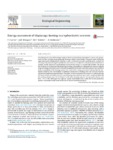Please use this identifier to cite or link to this item:
http://www.alice.cnptia.embrapa.br/alice/handle/doc/989879Full metadata record
| DC Field | Value | Language |
|---|---|---|
| dc.contributor.author | GARCIA, F. | pt_BR |
| dc.contributor.author | KIMPARA, J. M. | pt_BR |
| dc.contributor.author | VALENTI, W. C. | pt_BR |
| dc.contributor.author | AMBROSIO, L. A. | pt_BR |
| dc.date.accessioned | 2014-07-07T11:11:11Z | pt_BR |
| dc.date.available | 2014-07-07T11:11:11Z | pt_BR |
| dc.date.created | 2014-07-07 | pt_BR |
| dc.date.issued | 2014 | pt_BR |
| dc.identifier.citation | Ecological Engineering, v. 68, p. 72-79, 2014. | pt_BR |
| dc.identifier.uri | http://www.alice.cnptia.embrapa.br/alice/handle/doc/989879 | pt_BR |
| dc.description | Considering that most of the energy supply in Brazil is derived from hydroelectric sources, the govern-ment has been strongly encouraging cage farming in federal water bodies. The government limited the aquaculture parks in hydroelectric reservoir to only 1% of its total area and, inside the parks, a ratio of 1:8referring to the park and organic load dilution area. However, no objective evaluations proved that limit issuitable, and the absence of a methodology to evaluate this impact is a considerable problem. | pt_BR |
| dc.language.iso | eng | eng |
| dc.rights | openAccess | eng |
| dc.subject | Sustentabilidade | pt_BR |
| dc.title | Emergy assessment of tilapia cage farming in a hydroelectric reservoir. | pt_BR |
| dc.type | Artigo de periódico | pt_BR |
| dc.date.updated | 2014-07-07T11:11:11Z | pt_BR |
| dc.subject.thesagro | Políticas Públicas | pt_BR |
| dc.subject.thesagro | Oreochromis Niloticus | pt_BR |
| riaa.ainfo.id | 989879 | pt_BR |
| riaa.ainfo.lastupdate | 2014-07-07 | pt_BR |
| dc.contributor.institution | F. GARCIA, SÃO PAULO AGENCY OF AGRIBUSINESS TECHNOLOGY; JANAINA MITSUE KIMPARA, CPAMN; W. C. VALENTI, SAO PAULO STATE UNIVERSITY; L. A. AMBROSIO, SÃO PAULO AGENCY OF AGRIBUSINESS TECHNOLOGY. | pt_BR |
| Appears in Collections: | Artigo em periódico indexado (CPAMN)  | |
Files in This Item:
| File | Description | Size | Format | |
|---|---|---|---|---|
| EcologicalEngineeringJanainaKimpara.pdf | 959,51 kB | Adobe PDF |  View/Open |









